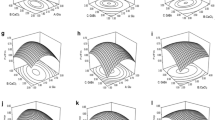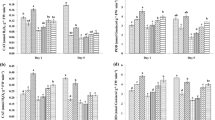Abstract
Chilling stress is an important constraint of global production of maize. This study was undertaken to compare the chilling responses of different maize seedling tissues and to analyze changes in polyamines as a result of chilling stress. Reponses to chilling were characterized in two maize (Zea mays L.) inbred lines, ‘HuangC’ and ‘Mo17’, that putatively differ in chilling sensitivity. Seedlings were exposed to low temperature (5°C) and chilling injury was estimated by electrical conductivity (EC), malonaldehyde (MDA) concentration, and by changes in putrescine (Put), spermidine (Spd) and spermine (Spm) concentrations in root, mesocotyl, and coleoptile tissues. Membrane permeability (as measured by EC), MDA concentrations and Put concentrations in the three tissue of maize seedlings increased after chilling stress, except for the Put concentration in roots. Spd and Spm concentrations in the three tissues of seedlings decreased after chilling stress. The EC for cold stressed tissues were lower in HuangC than Mo17. Also, the EC of coleoptile tissues were lower than for mesocotyl in both inbred lines. We suggest that mesocotyl tissue can be used to evaluate cold tolerance in maize. Stepwise regression analyses showed that chilling injury in roots was generally correlated with Spd concentration while in the mesocotyl injury was mainly correlated with Put and Spd concentrations. Spermidine and Spm concentrations in the coleoptile were correlated with chilling injury. Characteristics changes of polyamines in chill-tolerant maize seedling combined with regression analysis are a reliable method for evaluating chill tolerance in maize lines.
Similar content being viewed by others
References
Anderson MD, Prasad TK, Stewart CR (1995) Changes in isozyme profiles of catalase, peroxidase, and glutathione reductase during acclimation to chilling in mesocotyls of maize seedlings. Plant Physiol 109:1247–1257
Bouchereau A, Aziz A, Larher F, Martin-Tanguy J (1999) Polyamines and environmental challenges: recent development. Plant Sci 140:103–125. doi:10.1016/S0168-9452(98)00218-0
Dumortier FM, Flores HE, Shekhwat NS, Galston AW (1983) Gradients of polyamines and their biosynthetic enzymes in coleoptiles and roots of corn. Plant Physio1 72:915–918
Elste EF (1982) Oxygen activation and oxygen toxicity. Annu Rev Plant Physiol 33:69–73
Flores HE, Galston WA (1982) Analysis of polyamine in higher plants by high performance liquid chromatography. Plant Physiol 69:701–706
Gao CH, Hu J, Zheng YY, Zhang S (2006) Changes of antioxidant enzyme activities and proline content in maize seedling and their relationship to chilling tolerance. Chin J Appl Ecol 17(6):1045–1050
Hu LP (2001) Windows SAS 6.12 & 8.0 practical statistical analysis course. Military Medical and Science Press, Beijing (in Chinese)
Joseph M, Tomaso D, Jonathan JH, Leon VK (1992) Transport kinetics and metabolism of exogenously applied putrescine in roots of intact maize seedlings. Plant Physiol 98:611–620
Koetje DS, Kononowicz H, Hodges TK (1993) Polyamines metabolism associated with growth and embryogenic potential of rice. J Plant Physiol 141:215–221
Lee TM, Huu SL, Chu C (1995) Absisic acid and putrescine accumulation in chilling-tolerant rice cultivars. Crop Sci 35:502–508
Li HS (2000) Principles and techniques of plant physiological biochemical experiment. Higher Education Press, Beijing (in Chinese)
Liu N, Gao YB, Jia CY (2000) Changes in POD activity, free proline content and cytomembrane permeability of Lolium multiflorum leaves under different levels of osmotic stress. Plant Physiol Commun 36:11–14
Markowski A, Augustyniak G, Janowiak F (1990) Sensitivity of different species of field crops to chilling temperature: 3 ATP content and electrolyte leakage from seedling leaves. Physiol Plant 12:167–173
Nadeau P, Delaney S, Chouinard L (1987) Effects of cold hardening on the regulation of polyamines levels in wheat (Triticum aestivum L.) and alfalfa (Medicago sativa L.). Plant Physiol 84:73–77
Nayyar H, Chander S (2004) Protective effects of polyamines against oxidative stress induced by water and cold stress in chickpea. J Agron Crop Sci 190:355–365. doi:10.1111/j.1439-037X.2004.00106.x
Németh M, Janda T, Horváth E, Páldi E, Szalai G (2002) Exogenous salicylic acid increases polyamines content but may decrease drought tolerance in maize. Plant Sci 162:569–574. doi:10.1016/S0168-9452(01)00593-3
Páldi E, Szalai G, Marton CL, Pál M, Janda T (2002) Role of some N-containing compounds in chilling tolerance of maize. Acta Biol Szeged 46:99–100. In: Proceedings of the 7th Hungarian congress on plant physiology, S2-P11
Sepulveda G, Sanchez-de-Jimenez E (1988) Polyamine distribution among maize embryonic tissues and its relation to seed germination. Biochem Biophys Res Commun 153:881–887. doi:10.1016/S0006-291X(88)81178-1
Shen WY, Nada K, Tachibana S (2000) Involvement of polyamines in the chilling tolerance of cucumber cultivars. Plant Physiol 124:431–439. doi:10.1104/pp.124.1.431
Songstad DD, Duncan DR, Widholm JM (1990) Proline and polyamine involvement in chilling tolerance of maize suspension cultures. J Exp Bot 41:289–294. doi:10.1093/jxb/41.3.289
Sowiński P, Rudzińska-Langwald A, Adamczyk J, Kubica I, Fronk J (2005) Recovery of maize seedling growth, development and photosynthetic efficiency after initial growth at low temperature. J Plant Physiol 162:67–80. doi:10.1016/j.jplph.2004.03.006
Stamp P (1984) Chilling tolerance of young plants demonstrated on the example of maize (Zea mays L.). J Agron Crop Sci 7:1–83
Szalai G, Janada T, Bartók T, Páldi E (1997) Role of light in changes in free amino acid and polyamine content at chilling temperature in maize (Zea mays L.). Physiol Plant 101:434–438. doi:10.1111/j.1399-3054.1997.tb01018.x
Zheng YY, Hu J, Zhang S, Gao CH (2006) The identification of chilling-tolerance in maize inbred lines at germination and seedling growth stages. J Zhejiang Univ (Agric Life Sci) 32:41–45 (in Chinese with an English abstract)
Acknowledgements
The research was supported by National Nature Science Foundation of China (30370911). The authors are grateful to the editor and anonymous reviewers for comments that improved the presentation of the paper.
Author information
Authors and Affiliations
Corresponding author
Rights and permissions
About this article
Cite this article
Gao, C., Hu, J., Zhang, S. et al. Association of polyamines in governing the chilling sensitivity of maize genotypes. Plant Growth Regul 57, 31–38 (2009). https://doi.org/10.1007/s10725-008-9315-2
Received:
Accepted:
Published:
Issue Date:
DOI: https://doi.org/10.1007/s10725-008-9315-2




